|
|||||||||||||||||||||||||||
 |
|||||||||||||||||||||||||||
 |
|||||||||||||||||||||||||||
Essen | Saturday |
|||||||||||||||||||||||||||
 |
|
||||||||||||||||||||||||||
 |
|||||||||||||||||||||||||||
 |
|
||||||||||||||||||||||||||
 |
|
||||||||||||||||||||||||||
 |
|||||||||||||||||||||||||||


Rheinhold Friedl, founder and artistic director of zeitkratzer (time scratches), fulfills a long-standing plan for a homage to the late work of Luigi Nono with his piece “no: no.” The growing use of live-electronics on one hand and the simultaneous development towards an increasingly informal way of composition in Nono’s last works exerted a strong influence on Reinhold Friedl and could even be seen as one of the main sources of inspiration for the founding of zeitkratzer.
Zeitkratzer almost always work with electronic amplification, whereby every single member has developed individual sound techniques for his respective instrument. In this way, the individuation of the interpreter and the spatially oriented electronic concepts that Luigi Nono pursued in his late works find their counterpart in “no: no,” rounded out by the ensemble-oriented idea of work typical of zeitkratzer.

Marko Ciciliani, born in 1970 in Croatia, lived in New York, Hamburg and The Hague before settling in Amsterdam, where he has lived and worked since 1996. His work covers a broad range of music, from compositions for various ensemble combinations to sound installations to his own performances and improvisations.
For Zeitkratzer and “open systems 2005,” Marko Ciciliani wrote the piece “Spice Mélange.” A “spice mélange” results from the interaction of Orient and Occident. One starts with the Waltz, symbol of 19th-century Vienna – the 3/4 time that brought all of Europe to ecstasy. By injecting one further eighth-note into this triangle, the meter leaps in a single bound several hundred kilometers to the East, the Orient, where asymmetrical meters are so common. “Spice Mélange” is also a consciousness-expanding, life-extending drug (at least in Frank Herbert’s science fiction classic “Dune”), made available in this country for the very first time, exclusively on the occasion of this year’s festival.
In 1997, the founding idea of zeitkratzer was to unite young musicians into a single ensemble, who had, in their musical activities, transcended conventional genre definitions, in order to bring their openness and diverse experiences together into a new and fruitful form of work. This has entailed, on one hand, the direct collaboration between composers and musicians from widely divergent backgrounds; on the other hand, an interdisciplinary connection to other art forms. Since then, the ensemble has gathered a broad range of experience: zeitkratzer has worked with a wide variety of musicians associated with “nuova consonanza,” AMM, the New York downtown scene, Japanese noise-musicians, young electronic artists, avant-garde pop stars and New Music composers. The zeitkratzer line-up is international and is made up of a core group of ten musicians (including live electronics).
All members of the ensemble have made a name for themselves internationally as soloists and in other formations.
